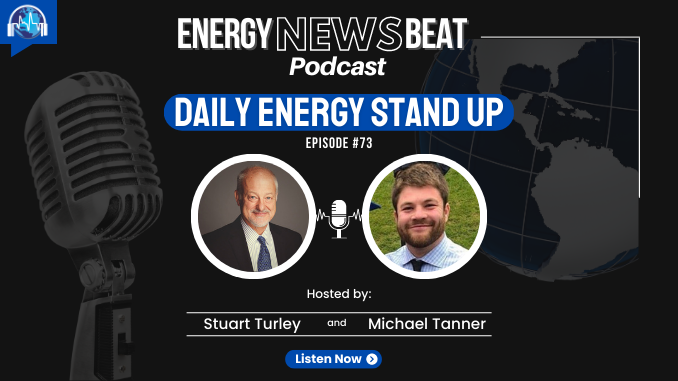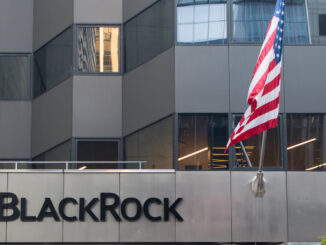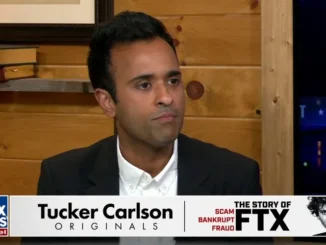
Top Stories of the week
The U.S. Has Billions for Wind and Solar Projects. Good Luck Plugging Them In. (NYT)
Pioneer’s Sheffield Predicting $90 to $100 Oil Price by Early Summer
Tesla’s Germany Plant Is Producing 4,000 Cars Per Week, Three Weeks Ahead Of Schedule
Highlight`s of the Podcast
00:00 Intro
00:35 – The US has billions for wind and solar in projects.
04:32 – Pioneer Sheffield
Predicting $90 to $100 oil by early summer.
05:37 -Pioneer expects to operate an average of 24 to 26 horizontal drilling rigs.
06:23 -Pioneer said it expects to place more than 100 of these extra long wells on production this year.
10:31 -Tesla’s Germany plan is producing four thousand cars per week three weeks ahead of schedule
12:21 – Atlantic LNG to lay off some staff
13:23 – India Coal is back in business
Follow Stuart On LinkedIn and Twitter
Follow Michael On LinkedIn and Twitter
Video Transcription edited for grammar. We disavow any errors unless they make us look better or smarter.
Michael Tanner [00:00:14] What’s going on? Everybody, welcome in to a special edition of the Daily Energy News Beat. Stand up, where we are reviewing the top stories for the week. Please sit back, enjoy this best of show on this gorgeous Friday. As always, these stories are brought to us by WWW.ENERGYNEWSBEAT.COM but I’m out of breath. Let’s turn it over to the show.
Stuart Turley [00:00:35] The US has billions for wind and solar in projects good luck plugging them in. This pretty cool article from like a like you said, from the New York Times, there’s a couple big things that has happened around the world and this one is really sparking it and there are more than 8100 energy projects. The vast majority of them are wind, solar and batteries. Our friends over there at Fry Battery out of Norway are coming in to take care of this as well, too.
Stuart Turley [00:01:06] But here’s the problem this is from our perspective, the interconnection process has become the number one project killer, said Piper Miller, vice president of market development at Pine Gate Renewables, a major solar power and battery developer. Michael, It’s a brain trust issue as well.
Stuart Turley [00:01:28] Two things really that are in this article. The EU is having to print money to catch up because now the brain trust, just like free energy coming across the pond, is now taking up a lot of this dollars and they’re having to create the same thing to attract people to go to Europe.
Stuart Turley [00:01:45] The brain trust people are fighting for these project engineers. Michael, You can’t get people approved to work on all of these projects wind, solar. The supply chains are not there. You may have the money. You may not get it done. It’s going. To.
Michael Tanner [00:02:03] I mean, think about this. I mean, it’s just that PJM interconnection, the one that stretches all the way from Illinois, in New Jersey, that way that will actually I think we should probably cover next. Right. Because it fits right in. But think about this. They’ve announced a freeze on new applications until 2026, so we can work through the already backlog of thousands of proposals, mostly for renewable energy. So.
Stuart Turley [00:02:25] Exactly.
Michael Tanner [00:02:26] The interesting part is it’s not just about, hey, can we build and spin up a wind farm, It’s where does the actual electricity tie into the grid you’ve been on for years, Stu don’t hurt yourself patting yourself on the back.
Stuart Turley [00:02:38] But here’s the thing. Like Merideth Angwin, who shorten the grid she brought up and David Blackman just talked about this in their podcast as well to the grid. And then I talked about it with Don Deers in my podcast. You have to add 180% when you bring in wind or solar for additional uptime guarantee instead of the normal 20%. So it is just nuts on this. Michael.
Michael Tanner [00:03:10] Peek about this, I love halfway down the article it is one of the bigger titles is imagine if we paid for highways this way a potentially bigger problem for solar and wind, and that is in many places around the country the local grid is clogged, unable to absorb more power.
Michael Tanner [00:03:24] That means that if a developer wants to build a new wind farm, it may not just have to pay for a simple connecting like, but also for deeper upgrades elsewhere. Get this still, these costs can be unpredictable. In 2018, North American Renewable Energy Bill proposed a 100 megawatt wind farm in southwestern Minnesota. Estimating he would have to spend $10 million year connected to the grid. But after the grid completed its analysis, EDP learned upgrades would likely cost upwards of $80 million and it canceled the project.
Michael Tanner [00:03:50] You know what this does do? It creates a whole new problem. When proposed energy projects drop out of the queue, the grid operator often has to redo the studies for other pending projects and ship costs to other developers, which could trigger more cancellations and delays. Dun dun dun.
Stuart Turley [00:04:04] It is about six things you said in there, Michael. There’s six things. I mean, the number one that I just said a second ago was there’s a brain trust missing from these people that can go through and analyze power, physics and everything else, that’s the number one job. It used to be it, folks. No is brain trust for energy trying to get things on the grid?
Stuart Turley [00:04:29] Hey, let’s start with our buddy pioneer Sheffield, predicting 90 to $100 oil by early summer. I love me some Sheffield. He is one of the best, coolest cats in the entire industry. And the article says Sheffield is talking to the end analysts and he says we remain highly constructive on oil prices, Sheffield told analysts. I’m still very optimistic that we’ll move back into the 90 to 100 range sometime early this summer as we move in, get away from this 78 to 88 swing and brant prices high.
Michael Tanner [00:05:08] Now this is what everybody does though, they couch their oil price by giving me Brant, which trades at a 7 to $10 premium to West Texas Intermediate, which pioneer and most other companies are produce out of the Permian and get paid off that index not Brant. So I do find it hilarious that he’s talking about his oil price and he chooses the international benchmark versus the one that sits in his backyard. But I won’t get hung up there. So continue.
Stuart Turley [00:05:35] The the other piece of this is Pioneer expects to operate an average of 24 to 26 horizontal drilling rigs and a lot of rig edge did. That’s a lot.
Michael Tanner [00:05:47] That’s a lot of rig age. We need to make that into a T-shirt. I don’t know if I’ve ever heard that that one before. I mean, Pioneer is probably one of the better positioned companies with their acreage in order to drill. I mean, they have vast.
Stuart Turley [00:06:02] Right.
Michael Tanner [00:06:02] You know, what is probably considered lower tier one at this point, but decent acreage that if these price is even at $75, make very good economic sense.
Stuart Turley [00:06:10] Let me ask you this. Yeah. Let me ask you this, Michael. It says, citing significant capital savings on a per foot basis of lateral wells in excess of 15,000 feet. Pioneer said it expects to place more than 100 of these extra long wells on production this year. Wow.
Michael Tanner [00:06:31] Yeah. I mean, it’s that’s super interesting and I think you’re seeing a shift of, you know, a shift into these super long laterals and we drag in 15,000 feet is three miles of lateral like I know in in the DGA basin oxy is doing some pretty crazy wells that are getting three or four miles. I just saw a permit for a Woodford well, up there in Oklahoma that was 26,000 feet of total measured depth. So I think that works out to like four miles.
Michael Tanner [00:06:57] I mean, it’s absolutely incredible Stu what they’re doing it. I think part of the reason why is because you can in high oil price environments which in which wells are fairly economical and you can really turn and burn this Tier one acreage. The longer you go it, it does. There is a on a well by well basis some economics of scale by increasing the lateral length.
Michael Tanner [00:07:20] You can increase the lateral length by a thousand feet and see a. Let’s give let’s say for example, a 100,000 barrel per thousand foot. And that’s a bad example. Let’s say let’s say 25,000 per 1000 foot of lateral length.
Michael Tanner [00:07:35] Well, if you go over 15,000 feet, your costs may not rise literally. They may slope off a little bit while E.U.R continues to rise and it does prices you can afford to be. You can, you know, a $22 million A.F.E, which is probably what it’s going to cost to go drill one of these wells.
Michael Tanner [00:07:52] You could swallow that because you’re going to you’re still going to be able to make your money back in 6 to 8 months. You know, and especially if you’re, quote unquote, highly constructive on oil prices, then there’s really only a time to go up from here because you might be able to lock in these rigs at $75. You know, service company prices went right to 100. You might there could be some saving.
Michael Tanner [00:08:12] So if that’s your thesis, it does make sense. I do think it’d be hilarious. You know, we talked on Friday, Stu, specifically about the rumor that Pioneer was going to buy Range Resources they had to announce a press release and say it’s going to happen.
Michael Tanner [00:08:25] I was on Twitter today and I fell out of my seat. I got to give a shout out this is one of the first what’s the name of this? The name of this Twitter account at insolvent shit go? I mean, it just I’m the guy who ever came up with brilliant. But the title was just not checkers. And if you don’t mind throwing up the meme for everybody on YouTube, it goes chess, not checkers.
Michael Tanner [00:08:48] So you’ve got the Winnie the Pooh meme where half the time he’s sitting there just looking scummy, and then the other half he’s in a suit, smiling first section, grinding on a model to evaluate whether M&A adds shareholder value or not part 2 or to leak rumor to Bloomberg and make that 1:30 p.m. deep dive. I’m telling you, it’s exactly what happened. It’s exactly what happened. They were like, Oh, let’s just leak the press, see what happens. Oh, stock down 4%. Bullet.
Stuart Turley [00:09:13] Bullet. Don’t do it.
Michael Tanner [00:09:15] Absolutely Funny. So, I mean, getting back to this, this article, Stu Pioneers, is going to be able to drill these long wells that will you know, even if they’re over AFV, they’ll be able to make money. But I do find it funny that, you know, now all of a sudden, we’ve got you know, I love how I have a hard time as an economist predicting commodity prices. I think that’s I think oil and gas companies should not be in the business of predicting oil prices.
Michael Tanner [00:09:41] You should be in the business of producing oil and gas for cheap as possible so that whenever the price does go down to a bad level, you’re able to continue to at least keep the lights on and when it goes up to an extremely high level, you’re able to keep those low operated assets, invest more drilling and really ramp up production because you really make most of your money on these oil wells in the first six months of production.
Michael Tanner [00:10:02] So it really isn’t matter what the strip prices for years out when you’re drilling these new wells because all you care about is that first six months. But here we’ve got Scott Sheffield, CEO of one of the largest companies in the oil and gas business. He’s not predicting oil prices, so this should be fun.
Stuart Turley [00:10:16] Hey, he’s a good dude.
Michael Tanner [00:10:17] What do you got next?
Stuart Turley [00:10:19] Tesla’s Germany plan. I’m actually quite happy about this because I do like Elon and I’m very happy for the Germans with this. Might as well make it off of the American company Tesla’s Germany plan is producing four thousand cars per week three weeks ahead of schedule. This is pretty amazing, Michael. Tesla will be compelling. $25,000 electric vehicle that is also fully autonomous, Elon said this time. Wow. After an ugly start to the 2023 campaign, Tesla shares have now more than doubled off their lows this year. It’s kind of cool.
Michael Tanner [00:11:00] Yeah, I mean, it’s pretty incredible what Elon Musk has been able to do. You know, first off, I think, you know, I don’t think the autonomous driving really gets enough. Doesn’t get talked about as much. You go with Tesla, everyone talks about the electric. They talk about the batteries, the cleaner.
Michael Tanner [00:11:15] I mean, really what’s going to make Tesla valuable is will they will they achieve what would be considered full self-driving or FSD? And who knows? But if they do. But if they do, it’s Licensable Software that can be licensed to any other company and all you need. And they really become a software company. And I think Elon knows that and I’ve been I’ve listened to enough podcast with him.
Michael Tanner [00:11:38] I’m surprised in the Lex Friedman show where he’s basically gone so far as to admit that Tesla is a software play and eventually might even be outsourcing and not even produce cars, but just produce software that goes into cars. But for now, they do make an incredible car. It’s clearly not $25,000 for it for a electric vehicle. That’s that’s a lie. I think it’s a 4550 now. It’s at least double that.
Stuart Turley [00:12:01] Oh, it’s way more than that. But the original idea for affordable Tesla was announced by Elon back in 2020. Tesla will make a compelling $25,000 electric vehicle. That’s also it was leaked from the company’s California plant.
Michael Tanner [00:12:19] Mm hmm.
Stuart Turley [00:12:19] So nice. Atlantic LNG to lay off some staff. And this is sad. We hate anybody getting laid off. As recent global events have been demonstrated, the LNG industry is dynamic. They shut down one of their trains. They have four trains and they are now down to three. And it’s because the limitations of the exports that are going on right now. Atlantic is one of the largest producers of LNG and is owned by the National Gas Company of Trinidad and Tobago and Shell, BP and the Chinese Investment Corporation.
Stuart Turley [00:12:59] Michael, here’s a tidbit. Guess who? Boston and New England. The story we had yesterday on New England Power.
Michael Tanner [00:13:08] Mm hmm.
Stuart Turley [00:13:09] They buy from this company
Michael Tanner [00:13:17] Of course they do.
Stuart Turley [00:13:19] Oh, yeah. I just thought I’d share that. A little bit of laughter. Let’s go to India coal is back in business. Michael, we just ran this story about King Coal last week again, and now we’re running another one. King Coal is coming back with a big bang, said Anil Kumar Jha, the chairman of Jindal Power. Holy smokes.
Stuart Turley [00:13:46] There’s no talk at all of phasing down coal at the event. Rather, the debate centered around on how just high coal’s demand will rise, with the consensus that it will jump to 1.4 billion tonnes per annum by 2030 from around 1 billion tons currently. How in the world, Michael, I want to ask you this one right now. How in the world can India make there, quote unquote, climate goals by increasing their goal from now on?
Michael Tanner [00:14:21] I think everything is a trade off. I think if they don’t increase their energy output to continue to provide low cost energy to their billion plus growing population, they’re going to find themselves in a position of very negative growth or not negative growth, but but slowing growth, I mean, they’re one of the fastest growing economies right now. I mean.
Stuart Turley [00:14:44] You know, we’re to China in population.
Michael Tanner [00:14:46] Yup. And from an economy standpoint, they’re booming right now and if you we’ve seen it here in the United States, what’s the easiest way to trigger a recession? Make the cost of energy skyrocket? Europe, energy prices have skyrocketed. So, you know.
Stuart Turley [00:15:03] Right.
Michael Tanner [00:15:04] India has continued to buy Russian crude. Why? Because they support the Russians. No, but they like cheap oil. They like cheap fuel. And so they’re going to lean that way as long as the incentive structure remains the way it is. I mean, you can commit anything to I’m going to commit to going on a diet starting tomorrow, but we’ll check in in two months, see how I’m doing. You know.
Stuart Turley [00:15:24] I’m holding my breath.
Michael Tanner [00:15:25] Exactly. So you that’s about as long as the diet will last. But if if you can keep if if there’s no incentive for me to have. You’re not going to pay me for one month, which you know who it may encourage me to go on a diet. But so I say all that to say they’re doing the right thing for them.
Stuart Turley [00:15:46] Exactly.
Michael Tanner [00:15:48] We cant necessarily be mad about it. What? I wish they were buying our LNG. Sure. But where would the LNG come when we can’t export it enough to satisfy their need quite yet? They’re going to go get it from Qatar.
Stuart Turley [00:15:59] Right. Now, here’s the thing. Yesterday we talked about China, how much they are building. They produce unbelievable amounts of energy, their coal they’re doing to weak. You know, just by that. So anyway, I just wanted to shout out I mean, you’ve always heard me say this. I love India. I love the leadership for trying to get low cost power. And I know you’re shaking your head. Yes. You’re already tired of saying it.



